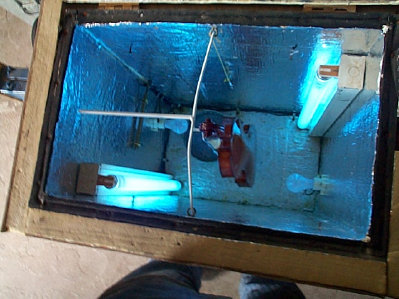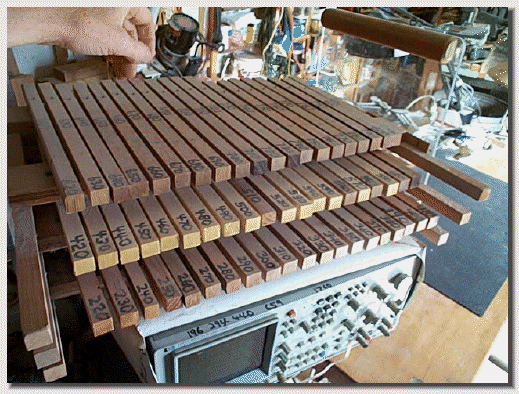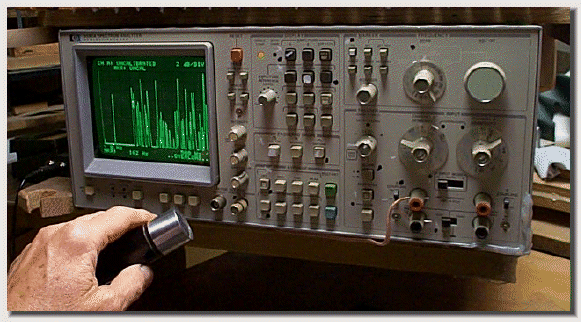...This tool is really just bars of quarter sawn wood about 1" square (the tree rings go up and down as viewed from the end) of varying lengths. The bars are adjusted so they tap precisely the frequency as noted on the ends. Notice how they go from 220 HZ to 810 HZ, in incriments of 10 HZ. (and now down to 120HZ).
{.. I have since found that the range of from 120 HZ to 410 HZ is adequate/ ideal, for violin making. }
By tapping on the ends of the tone strips, one can quickly discover the area ("family") of sound that compares with our unknown tap sound.
...The bars are supported at 22.4% of their length in from each end on a strip of felt glued to the bottom side.
...They can be tapped either at the center or at either end.
(updated 10/2020)
Page AA_12
SonaDecaFer, Design and construction...
"Sound / units of 10 HZ / Tool"
...If wood were perfectly uniform, then we could just cut these wood blocks so they were all the same cross-sectional size (say 1" by 1") and then vary the length according to the formula (from an acoustical textbook), and we would have a set of reference tap blocks:

...Select wood that has good sound transmission properties (slide your hand along the edge of the wood you are considering to use; does the wood make a clear sound or is it muted and soft?) Cut identical sized (width and height) pieces quarter sawn and various lengths, according to our formula; then adjust them to their final frequency by sanding the top evenly to slightly lower the tone and sanding each end slightly to raise the tone. Support each block 22.4% in from each end on a strip of hard felt glued underneath. It is probably necessary to use a sound analyzer to measure the frequency of each strip so you can adjust them accurately. {A microphone and a personal computer driven sound analyzer program should work well enough though.}
...Based on recent investigation (2017), I would suggest the ideal wood strips would be on the Wood Tone Scale (exactly) and have a Rub Tone of the ideal # 22. Probably for spruce the Wood Tone ideal would be 198 HZ.
22.4% of length
Two felt blocks
Tap
Here
(end view...)
Finish nail through a slightly larger drilled hole in the wood sound strip, pushed into place.
Two support rails under felt:
(only one shown)
...In my opinion, this tool is vital for accurately working with instruments using a tap tone adjustment technique. First, I got my H.P. Sound Analyzer and then used it to make and adjust my SoniDeciFer sound reference wood bars.
...When tapping on a piece of wood, the 'tapper tool' makes a sound as well, so our ears must try and differentiate between the two tones; thus we want to use a tapper that adds little sound of its own, or is above or below the frequency of the wood we are trying to measure, that we can concentrate on the object of our attention, not the tapper.
...The second knuckle of the middle finger is the best tapper of all; generating the Tap Tone of the wood.
...The first knuckle of the middle finger is generates the Wood Tone of the wood. {A leather mallet also generates the same Wood Tone feature}
...The eraser end of an ordinary wooden pencil the next best. (this saves on your knuckels and can get in much smaller spaces. The wooden end of the pencil is most useful if used carefully.
...{Using the fleshy end of the finger is useful as well when checking evenness of violin plates.}
...Wooden pencils often generate a lot of sound when they are used to strike another wooden object. Try and find a tapping pencil that gives a very dull 'thud' sound. This will make your ear much more effective.
...The well respected violin make,r Daniel Paris told me that the only sound analyzer he had discovered, that can analyze a 'tap on a piece of wood' is this one make by Hewelt-Packard in the 1980's {Model # 3582A}. He was kind enough to find me this used example which I purchased. The screen shows a typical frequency analysis of a tap on wood; all the various frequencies and how strong each one is. It does require some practice to begin to get usable results, but is often a good 'second opinion' when I am not sure of a tone. It is however the perfect tool for making and adjusting your own set of wood tone reference tone blocks with scientific accuracy.

...The next tool I want to tell you about is an Ultra Violet Light box. This is an adjunct to natural sunshine, for those days when the sun does not shine or when you want to subject a part to concentrated and even-all-over U.V. light absorption at the same time.
...It can also double as a warming box to get the wood parts up to about 100 degrees F. before gluing operations with hide type natural glues which require warm conditions for best results. For instance, my violin shop is unheated and it is helpful and important that the wood pieces I am going to glue together be about 100 degrees F. during the joining process (remember, the glue is at 150 degrees and the hide glue will gell if it cools suddenly).

...The design is basically just a wood box with insulation foam panels on the outside; a hinged lid, top sealing gasket.
...There are two light bulbs in porcelin sockets screwed to the sides at bottom on a house hold dimmer switch to control how much heat they make. Notice the pan of water in the bottom. This is to prevent a completed violin from drying and and cracking.
...The fluorescent light bulbs are special ones that give off high concentrations of Ultra Violet light. They are 24" long and 20 watt power on a standard house light switch. I have an external temperature gage mounted to monitor inside temperature.
...You may note that I have a counterweighted bracket to hang a violin on. The heavy duty aluminum foil (shiny side to the inside) is glued to the plywood structure with silicone caulking. This reflects the U.V. light evenly all around the parts, if wanted.
...Any part that you want to protect from U.V. light absorption, you cover with aluminum foil. Do not let the fingerboard be exposed to the U.V. light as it might warp.
Bulb information: General Electric 24", 20 watt # 10244 / F20T12/BL
Marked on bulb: F 20 T 12-BL / Black Light / 20 watt






















